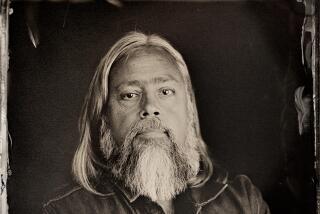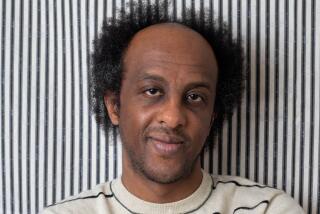David Payne’s ‘Barefoot to Avalon’ avoids easy answers in a tale of two brothers
On Nov. 8, 2000, David Payne’s younger brother, George A., died in a car wreck north of Roanoke, Va. Payne, the lead driver in an impromptu two-vehicle caravan, watched the whole thing unfold in his rearview mirror. His brother was helping him transport belongings from Vermont to North Carolina as part of a move.
This is the impetus for “Barefoot to Avalon: A Brother’s Story,” Payne’s first book of nonfiction after five novels, including “Confessions of a Taoist on Wall Street.” To say “Barefoot to Avalon” is about the accident, however, is to underestimate what Payne has achieved.
George A., who was 42 when he died, suffered from Bipolar I Disorder and had been through multiple breakdowns and hospitalizations; he had lost his job, his marriage, his self-sufficiency, living with his mother for the last nine years of his life. Payne, for his part, had “failed to see what had happened to George A. and had let things shutter down till there was almost no light left between us.”
The brothers’ trip together, then, was meant to be a reclamation project, a way of bringing them back into proximity again. That it ended as it did is just one of the many tragedies that permeate this piercing book.
For Payne, it is a key motif: that one tragedy cannot stand apart from all the others, that we live at the mercy of a heritage, a history, we can never fully understand. To emphasize this, he uses the accident as a lens, a filter, through which to examine the tentative good will of brothers who share a set of grievances as well as a grudging sort of love.
As they prepare to hit the road, Payne tells George A. he’s a good brother; “It’s okay, David,” the younger man responds. “Only later does it nag me,” Payne recalls, “that George A. didn’t say, ‘You’re a good brother, too,’ or ‘You’ve helped me in the past, so I help you,’ or any of the countless things he might have said. What he says is, ‘It’s okay, David,’ not resentfully, but like someone at the end of a long contest, who’s been on the receiving end of something and is ready to forgive it.”
That quality, of coming to the close of something, represents the essential beating heart of the book. Payne is not interested in the accident for its own sake; for most of “Barefoot to Avalon,” he avoids it, although when he finally describes it, as he must, it is a tour de force.
More to the point, he wants us to see the accident as the result of a larger set of accidents that has been ongoing for half a century, involving their parents’ misbegotten marriage and the alcoholism and mental illness on both sides of the family, including a rather stunning collection of suicides.
This is dangerous material — not only because it is revealing but also because it could so easily tilt to the clichéd resolution of the recovery memoir. Yet recovery is not what Payne has in mind. He dispenses with his own sobriety in a single sentence, and as for his brother, he has no answers, even now.
“I imagine that, for George A,” he writes, “it reached that point … where the spotlight hits you and you don’t know what the play is or the character you’re playing, and it doesn’t matter how hard you’ve worked.” The same holds true for other members of his family: his mother, trying desperately to keep George A. together; his father, an eventual suicide himself, after decades of anger and drink.
Interwoven is Payne’s story, that of the aspiring poet who became a novelist, all the while prone to his own toxic mix of alcohol and rage. Early in the book, he describes an encounter with his son, Will, then 6, that explodes when the boy refuses to eat what he is served. “[D]on’t you do that,” Payne screams. “Don’t you mock me. I won’t be mocked by you, you hear me?” Eventually, he realizes he has “become my father, annihilating Will the way Bill once upon a time annihilated George A. and me.”
It’s a key moment, not because it allows Payne to push off blame for his behavior but because he has no choice but to face his failure; he’s become what he most hates. Later, a scene between his father and himself in a Boston hotel room works as something of a psychic mirror, offering not reconciliation but complicity. “Get back in bed or I’m going to kill you,” his father yells at him, “and it’s as if our life together is a swath of decorative wallpaper that suddenly tears and shows the black depths of outer space.”
Those depths, they encompass everyone in “Barefoot to Avalon” — even Payne. He is the survivor, but there is nothing noble about that, no great lesson to be learned. Rather, his narrative moves from scene to scene with the logic of memory, as if this were less a story than a collection of fragments that refuse to coalesce.
It’s another risk, to frame the story as a set of open-ended questions, but that’s exactly what makes it so resonant. What could Payne have done for George A.? How much responsibility does he, does anyone, bear? In the end, he comes to the only available conclusion: that everyone is fighting his or her own private war.
“Please God,” Payne asks, “don’t make me carry this, don’t make me responsible, let my brother be alive, I require it of you, I compel You because if he isn’t and I’m responsible then the universe is intolerable and I return my ticket. Yet the sky was empty and returned no answer and here I am.”
david.ulin@latimes.com
Barefoot to Avalon
A Brother’s Story
David Payne
Atlantic Monthly Press: 294 pp., $26
ALSO:
In ‘Pretty Baby,’ an act of kindness spirals into dangerous territory
Jamie Brisick describes Peter Drouyn’s journey to ‘Becoming Westerly’
Joshua Mohr’s ‘All This Life’ delves into death, divorce and addiction in the digital age
More to Read
Sign up for our Book Club newsletter
Get the latest news, events and more from the Los Angeles Times Book Club, and help us get L.A. reading and talking.
You may occasionally receive promotional content from the Los Angeles Times.







